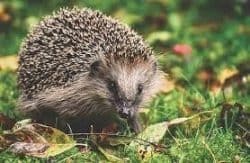There are many species of animals that are suffering from habitat loss around the UK and the world. As more land is taken up by building, or for farming, then many of the habitats that creatures rely on for food, a home and their lives are lost for good, and with it sadly, so is the wildlife.
One of the best examples of this are the hedgerows. Something that is synonymous with Britain, our hedgerows are a big part of that ‘green and pleasant land’ that we call home. But with hedgerows now being lost to building, this is hugely detrimental to many species of mammals, insects and birds.
If you have a garden, something that you can do is to grow your own hedgerow there. This can help to provide the nearby animals with a sanctuary – you may notice the birds using a hedgerow in the spring to build their nests, or the many smaller animals collecting berries from it in the autumn. On a lazy summer day, you can see the butterflies and bees that hover around it, and even in the depths of winter, a hedgerow provides shelter for animals like frogs and hedgehogs.

If you are planting a deciduous hedgerow, then this is a great time to do it. Any time between the autumn when the leaves start to fall from the trees, and the late winter when trees and plants start to come back into bud is a good time for this activity. Species of native plants that are great for a hedgerow include hawthorn, blackthorn and beech.

Go to a specialist who can provide you with the plants that you need for your hedge like this plants for trade Kent based company https://www.palmstead.co.uk/ . Usually, they will come bare rooted, so make sure that you keep the frost away from them whilst you are waiting to plant them.
Preparing the soil properly first is essential to a good foundation, and when you are planting it remember to set it a little further back from the boundary, as that gives it room to grow in the spring and the summer without causing it to intrude.
For the first few years, take care of the hedge in the summer months by watering it when it is particularly dry and use a good fertiliser to encourage growth.

